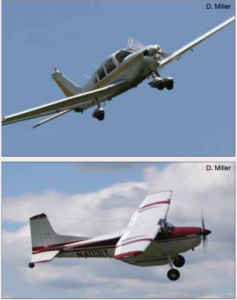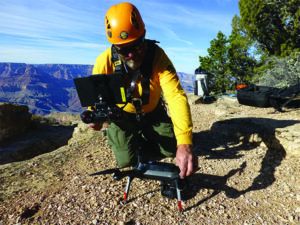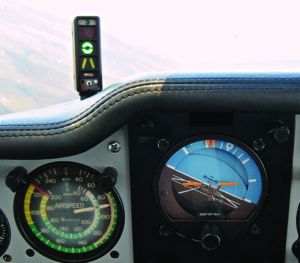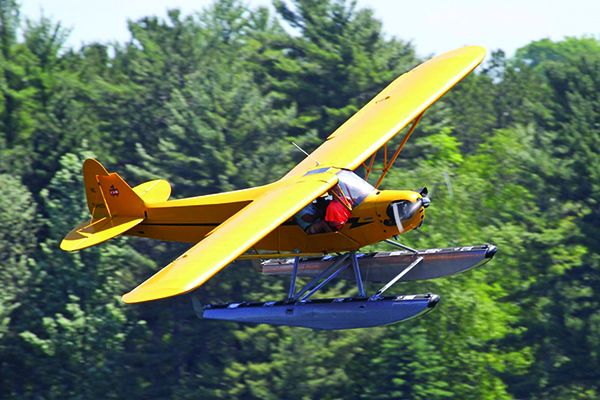On September 5, 2013, a hunter near Glenallen, Alaska, was killed in a crash while searching for a moose he had earlier shot and field-dressed. According to a friend who was hunting with him, the pilot had failed to mark the area where the carcass could be found before hiking away from the site and subsequently chose to conduct a quick aerial search for it in his Cessna 170B. As the witness later recounted to investigators, the pilot flew by at about “80 to 100 feet above the ground traveling at about 45 mph.” The aircraft then started a left turn, pitched down, began to spin and collided with terrain. The NTSB later determined the accident’s probable cause was the pilot’s “failure to maintain adequate airspeed while maneuvering at low altitude.” In Alaska, this sort of accident is commonly known as a “moose stall.”
While the Glenallen crash involved a private pilot flying under Part 91 during hunting season, many similar accidents in the state have occurred under professional conditions and even with FAR Part 135 pilots. In November 1996, both the charter pilot and State of Alaska wildlife biologist aboard a Cessna 185 were killed when they crashed near the village of Marshall while conducting a moose survey. In December 2002, an Aviat A-1B Husky operated by a National Park Service pilot crashed near the village of King Salmon, killing the pilot and leaving the observer with serious head injuries. The purpose of that flight was to locate a radio-collared moose. In October 2009, conservationist Gordon Haber was killed in Denali National Park and Preserve while using radio telemetry to track the wolf packs he had studied for decades. The pilot in that accident, who was flying a Cessna 185 under FAR Part 91, survived with serious injuries.
NOT JUST ALASKA
While it can be tempting to dismiss these accidents and others like them as an “Alaska problem,” they occur with startling frequency in the Lower 48 as well. In October 2010, two National Park Service ranger pilots were killed in Utah’s Dixie National Forest while on a personal flight in a privately owned Cessna 172, elk-spotting for an upcoming hunting trip. Two years earlier, a bear biologist and his pilot were killed upon their return to Placid Lakes Airport in Florida. Witnesses reported the Piper Super Cub flew along the runway at “between 40 and 100 feet above the ground” before an “abrupt pull up” and then a left turn, rapid descent and collision behind the tree line. The half-hour flight had been conducted for the purposes of locating a bear with a tracking collar. According to images later recovered from the passenger’s camera, the aircraft had flown exceedingly low during the flight and, in at least one instance, its tires were in contact with the surface of a nearby lake.
Trying to find direct comparisons between any of these flights is exceedingly difficult. Weather was largely not a factor in any of them, with the exception of Dixie Forest and Denali Park, where investigators noted in their probable cause statements that windy conditions should have merited more particular concern from the pilots. The aircraft were all piston singles, although they were operated in a variety of different manners, from privately owned personal flights, to public-use, to aerial observation under FAR Part 91 and Part 135 charters. Pilot flight time provided a huge range of experience from the low time of the Glenallen and Dixie Forest pilots (186 and 260 hours, respectively) to 1246 hours for the Florida pilot, 4400 for the Denali Park pilot, 10,500 for the National Park Service pilot in King Salmon and 16,000-plus hours for the air taxi pilot on the flight in Marshall.
Then there is the case of a May 2005 crash of a Cessna 172 on the beach in Coney Island, New York. That flight, conducted as flight instruction under FAR Part 91, killed the pilot and all three passengers. According to radar data, the aircraft was at “300 feet and had a ground speed of 60 knots” just prior to the crash. Dozens of witnesses gave statements to local police, all echoing similar reports from the other crashes mentioned in this article: The aircraft was flying low and slow, it made a sudden turn and it plummeted nose-first into the ground. In the course of the investigation, the NTSB determined that the flight had been sold as a “Discovery Flight,” advertised by the pilot’s employer to get would-be pilots “hooked on flying!” After the crash, Air Fleet Training stopped allowing additional passengers on its instructional flights and relocated them to a designated practice area. The accident pilot in this accident had just over 1900 hours.

Depending on applicable regulations, wildlife spotting per se isn’t illegal, immoral, fattening or otherwise proscribed, and neither are steep turns with little altitude above ground. Presuming, that is, you obey some other laws, specifically those of aerodynamics. And you always need to heed FAR 91.119, dealing with minimum safe altitudes.
The problems with steep turns at low altitude are several, including diversion of the pilot’s attention outside the airplane, the greater load factor when a steeply banked turn is made while maintaining altitude and the likelihood of doing all this at a reduced power setting—after all, the idea is to remain over a specific location to observe what’s on the ground.
In our view, a better way to meet this need is to adopt a personal rule that you won’t bank the airplane more than 30 degrees and that you won’t turn more than 45 degrees at a time over the location. Add to this personal rule that you won’t try to remain on top of a specific location but will fly over it, and then climb out straight ahead to a safe altitude. To repeat the observation, turn 180 or so degrees, descend back to the desired altitude and pass over the location, initiate a climb back to a safe altitude and repeat. By keeping the wings more or less level and avoiding major heading changes, you’ll also avoid the low, slow, turning trap of moose stalls. — J.B.
LOW ALTITUDE
There are human factors to discuss in all of these accidents, which would center on the need for pilots to remain focused on the task of flying rather than succumb to distractions such as searching for an animal, entertaining passengers or the scenery out the window. These concerns are not new to aviation. It is worth noting how serious of a problem low-altitude/low-airspeed accidents are in the field of wildlife biology, however. In a study published in the peer-reviewed journal Wildlife Society Bulletin in 2003, a researcher analyzed job-related deaths for wildlife biologists between 1937 and 2000. He determined that 66 percent of those fatalities were due to aviation accidents, with stalls and power-line collisions as the most common causes. In addition to the accidents with biologists cited above in Alaska and Florida, since the article’s publication there have been multiple fatality accidents with wildlife biologists involving aircraft and helicopters in at least Oregon, Idaho, Texas, Washington and California. It is largely because of the ongoing safety issues for biologists in the air that many organizations have moved to the use of unmanned aerial vehicles or drones for their work (see the sidebar above).

Since the late 1990s, biologists have been experimenting with drones in various ways, but they attained widespread use only recently. For example, drones are replacing snowmobiles in surveying polar bears and musk oxen in Alaska’s Wrangell Island Nature Reserve as well as for tracking and aiding whales entangled in fishing line off the coast of Hawaii. There is some reasonable concern that recreational drone users will harass and endanger wildlife and studies have shown that drones can cause heightened physiological responses among some animals. Overall, however the response has been positive and drone use for biologists will likely only expand in the future.
For some animals—walruses are particularly prone to stampeding when startled, which can result in mass death for their young—drones have been particularly crucial. After a 2010 triple fatality helicopter crash in Hells Canyon, Idaho, while surveying salmon, biologists there embraced the use of a hexacopter. “Safety is the key for why we’re doing this,” Idaho Power biologist Brad Alcorn told the National Wildlife Federation magazine in 2019. “Not only is it safer, but it’s giving us better data.”
Meanwhile, it’s important to note that drone operation may be illegal within state and federal parks and wildlife preserves, and aircraft pilots often are requested to fly at or above certain minimum altitudes.
AOA INDICATORS
A solution for low-altitude/low-airspeed accidents that is gaining in popularity is the wider use of angle of attack (AOA) indicators. Once found primarily in military aircraft and corporate jets, digital AOA indicators are now much more accessible and affordable. Rather than relying on airspeed indicators for stall avoidance, AOA indicators provide pilots with a unique warning when the aircraft is approaching the critical angle of an aerodynamic stall. (The FAA defines AOA as “the acute angle between the chord line of the airfoil and the direction of the relative wind.”) The AOA indicators on today’s market can provide visual (color changes) and/or aural warnings to pilots as the angle of attack is neared.
A key aspect of flight safety that AOA indicators address is the variability of conditions that impact a pending stall. Pilots can be lulled into thinking that as long as a certain airspeed is maintained, the stall will not occur. However, changing circumstances, from gross weight to pitch to variable wind conditions, can cause a stall well above that speed. Further, when attention is diverted elsewhere, recognition of potential or pending stall conditions is diminished, if not lost altogether. An AOA indicator adds another layer of safety that increases situational awareness. Along with avoiding distraction, the technology can be a life-saver.

The University of North Dakota (UND) installed angle of attack indicators into its fleet of 120 aircraft several years ago as part of a study to determine their effectiveness. One initial finding was that on the base-to-final turn, pilots with AOA indicators would typically drop about 0.7 degrees as opposed to pilots without them. This led to a possible finding that the pilots with the indicators were “responding to the angle of attack awareness and lowering the nose when turning final.”
A study spearheaded by the FAA called PEGASAS (Partnership to Enhance General Aviation Safety, Accessibility and Sustainability) studied mechanical AOA indicators with three different universities (separate from the UND study) to measure the variability of flight path angle during the final moments of an aircraft approach. One interesting conclusion was that having a visual representation of “where they are in the flight envelope” was helpful to pilots and assisted in maintaining situational awareness. More studies are ongoing, but you can read about the FAA’s work on AOA indicators in a 2018 issue of FAA Safety Briefing available online as a PDF at tinyurl.com/SAF-PEGASUS.
GENDER REVEALS: A WORD
There are of course some accidents no piece of technology or training could prevent. In September 2019, an Air Tractor AT 602 crashed in Turkey, Texas, after dumping about 350 gallons of pink water for a gender-reveal party. In this case, the pilot, who had 14,000 flight hours, was conducting the air drop for a friend when he failed to maintain proper airspeed and, according to the NTSB’s probable cause determination, exceeded “the airplane’s critical angle of attack during a low pass, which resulted in an aerodynamic stall and impact with terrain.” This crash is certainly the most puzzling of all those discussed in this article as agriculture pilots are uniquely trained for maneuvering at low altitude with low airspeed. The answer for how it happened is found in a brief interview summary in the accident docket release.
It was already curious that the accident report mentioned there was a passenger aboard the aircraft as the AT 602 is designed for only a single occupant and the on-site FAA inspector confirmed for the NTSB that there was, indeed, only one seat. In describing how the passenger was accommodated, he said he thought the pilot “moved to the right and the passenger was sitting on the edge of the seat on the left side.” I’m sure anyone can understand how properly flying an aircraft while sharing a single seat would be problematic. I suppose we should just chalk this one up to bad decision-making from the very beginning and be grateful only minor injuries were sustained.
Moose stalls aren’t the greatest risk we face in the cockpit, but they are one of the most preventable pilot-related accident causes. Any time you’re low and slow, and turning steeply, alarm bells should go off—well before the stall warning. Level the wings, add power and climb away.
Colleen Mondor is a private pilot with degrees in Aviation Management, History and Northern Studies. She has written about, and worked in, Alaska aviation for 25-plus years.





Moose stalls aren’t the greatest risk we face in the cockpit, but they are one of the most preventable pilot-related accident causes. Any time you’re low and slow, and turning steeply, alarm bells should go off—well before the stall warning. Level the wings, add power and climb away.
I would add to this statement …. anytime you are doing something that you would not normally do in the course of your flying ie low pass to inspect an airfield or to impress the people on the ground, or for the sheer hell of it …. stop and think … do I really need to do this ? and then DON’T DO IT….
Very interesting article. I had a friend do a ‘moose stall’ 20 years ago with a deputy sheriff observer while looking for an elderly cognitively impaired person. It’s highly probable that my friend forgot who was the ‘observer’ and who was the Pilot In Command. Both died in the resulting stall/spin.